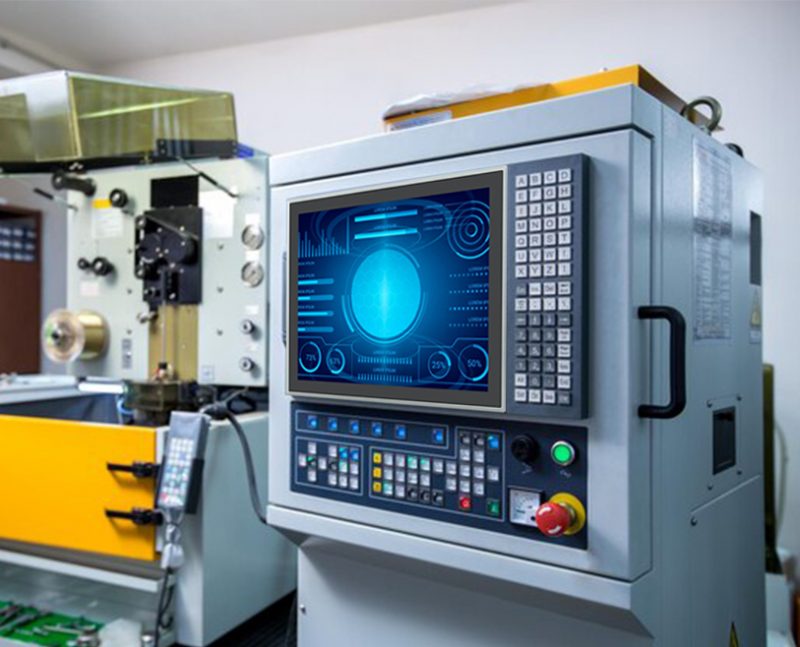Da sich die globale Fertigung auf Nachhaltigkeit und umweltbewusste Abläufe verlagert, Öko-Automatisierung hat sich zu einem Eckpfeiler umweltfreundlicher Industriepraktiken entwickelt – und energiesparende industrielle HMI-Bildschirme sind führend bei der Optimierung der Effizienz. Im Gegensatz zu herkömmlichen industriellen HMIs, die übermäßig viel Strom verbrauchen, Diese Spezialbildschirme vereinen fortschrittliche energiesparende Technologien mit robuster Leistung, Dadurch können Hersteller den Energieverbrauch senken, ohne die Betriebskontrolle zu beeinträchtigen. Ob integriert in Smart Factorys, erneuerbare Energiesysteme, oder automatisierte Produktionslinien, Energiesparende industrielle HMI-Bildschirme ermöglichen eine intuitive Mensch-Maschine-Interaktion, Datentransparenz in Echtzeit, und wirkungsvolle Energieeinsparungen – alles entscheidend für das Erreichen der Öko-Automatisierungsziele.
In diesem Artikel werden ihre Kernfunktionen untersucht, Schlüsselanwendungen, und transformative Vorteile, Unterstützung von Industrieführern und Nachhaltigkeitsmanagern bei der Auswahl von HMI-Lösungen, die auf Umweltziele und betriebliche Anforderungen abgestimmt sind.

Kernmerkmale energiesparender industrieller HMI-Bildschirme
1. Fortschrittliche, stromsparende Display-Technologien
Die entscheidende Stärke energiesparender industrieller HMI-Bildschirme liegt in ihrer energieeffizienten Anzeigetechnik, Entwickelt, um den Stromverbrauch zu minimieren, ohne die Leistung zu beeinträchtigen:
LED-hintergrundbeleuchtete IPS/LCD- oder OLED-Panels: Verbrauchen Sie 30–50 % weniger Energie als herkömmliche Displays mit CCFL-Hintergrundbeleuchtung, mit OLED-Varianten, die Dimmung auf Pixelebene für weitere Einsparungen bieten.
Adaptive Helligkeitsregelung: Sensoren passen die Bildschirmhelligkeit automatisch an das Umgebungslicht an (Z.B., Dimmen in Fabriken mit wenig Licht, Aufhellung im Freien), Reduzierung unnötigen Stromverbrauchs um 15–25 %.
Energiesparmodi: Anpassbare Schlaf-/Wachzyklen (Z.B., Dimmen danach 30 Sekunden Inaktivität, Standby danach 5 Minuten) Reduzieren Sie den Stromverbrauch um bis zu 70% während der Leerlaufzeiten.
2. Robust, Umweltfreundliche Konstruktion
Gebaut für industrielle Haltbarkeit, wobei Nachhaltigkeit im Vordergrund steht, Diese HMIs kombinieren Widerstandsfähigkeit mit grünem Design:
Materialien in Industriequalität: Recycelbare Aluminiumrahmen und VOC-arm (flüchtige organische Verbindung) Beschichtungen reduzieren die Umweltbelastung, ohne die Festigkeit zu beeinträchtigen.
Robuster Schutz: Schutzart IP65+ gegen Staub und Wasser, breite Betriebstemperaturbereiche (-20°C bis 60 °C / -4°F bis 140°F), und Vibrationsfestigkeit (IEC 60068-2-6 konform) Sorgen Sie für Langlebigkeit in rauen Umgebungen und minimieren Sie Austauschzyklen und Elektroschrott.
Komponenten mit langer Lebensdauer: Hochwertige Kondensatoren und LED-Module bieten 50,000+ Betriebsstunden, Verlängerung der Produktlebensdauer und Reduzierung des CO2-Fußabdrucks durch häufigen Austausch.
3. Intuitive Steuerung & Energieüberwachung in Echtzeit
Energiesparende industrielle HMI-Bildschirme ermöglichen es Bedienern, durch intelligente Funktionalität sowohl den Arbeitsablauf als auch den Energieverbrauch zu optimieren:
Berührungsreaktion mit geringer Latenz (≤5ms): Gewährleistet eine sofortige Interaktion zur Anpassung der Automatisierungsparameter, mit Multi-Touch-Unterstützung (bis zu 10 Punkte) für komplexe Befehle – Beseitigung von Ineffizienzen durch Verzögerungen.
Integrierte Energie-Dashboards: Echtzeit-Visualisierung des Stromverbrauchs (Z.B., pro Maschine, pro Produktionslinie) ermöglicht es Bedienern, Energiefresser zu identifizieren und Prozesse im Handumdrehen anzupassen.
Umweltwarnungen: Anpassbare Benachrichtigungen bei abnormalem Energieverbrauch (Z.B., eine Maschine, die überschüssige Energie verbraucht) ermöglichen proaktives Eingreifen zur Vermeidung von Verschwendung.
4. Nahtlose Integration mit Öko-Automatisierungssystemen
Die Kompatibilität mit umweltfreundlichen Automatisierungstechnologien ist von entscheidender Bedeutung – und diese HMIs lassen sich nahtlos in nachhaltige industrielle Ökosysteme integrieren:
Unterstützung für Industrieprotokolle: Funktioniert mit PROFINET, Ethernet/IP, Modbus TCP, und MQTT, Ermöglicht die Kommunikation mit Energiemanagementsystemen (EMS), SPS, und Ausrüstung für erneuerbare Energien (Z.B., Solarwechselrichter, Windkraftanlagen).
IoT-Konnektivität: Cloud-integrierte Modelle werden mit Smart-Factory-Plattformen synchronisiert, um Energiedaten zu aggregieren, Ermöglicht Fernüberwachung und KI-gestützte Effizienzoptimierungen.
Modularer Aufbau: Panelmontage, Armhalterung, oder Desktop-Optionen passen sich verschiedenen Eco-Automation-Setups an, von Solarparks bis hin zu energieeffizienten Produktionslinien.
5. Einhaltung grüner Standards
Energiesparende industrielle HMI-Bildschirme erfüllen globale Zertifizierungen für Nachhaltigkeit und Energieeffizienz, Sicherstellung der Ausrichtung auf die Öko-Automatisierungsziele:
Energiestern, CE, und RoHS-Konformität: Gewährleistet einen geringen Stromverbrauch und die Einschränkung gefährlicher Substanzen (Z.B., führen, Quecksilber).
ISO 14001-konformes Design: Hergestellt mit umweltfreundlichen Produktionsverfahren, Reduzierung des Wasser- und Energieverbrauchs während der Herstellung.
Hauptanwendungen energiesparender industrieller HMI-Bildschirme in der Öko-Automation
1. Intelligente Fabriken & Nachhaltige Produktionslinien
In umweltbewussten Produktionsstätten, Diese HMIs treiben die energieeffiziente Automatisierung voran:
Prozessoptimierung: Energie-Dashboards in Echtzeit ermöglichen es Vorgesetzten, Produktionspläne anzupassen (Z.B., Verlagerung von Hochleistungsaufgaben in die Nebenzeiten) um Netzbelastung und Energiekosten zu minimieren.
Gerätekontrolle: Überwacht und reguliert den Energieverbrauch von Robotern, Förderer, und Maschinen, um sicherzustellen, dass sie mit optimaler Effizienz arbeiten (Z.B., Reduzierung der Leerlaufleistung von Pumpen oder Motoren).
Abfallreduzierung: Integriert sich in Qualitätskontrollsysteme, um Materialverschwendung zu minimieren, Ausrichtung an den Prinzipien der zirkulären Fertigung.
2. Erneuerbare Energiesysteme (Solar, Wind, Wasserkraft)
Für erneuerbare Energieanlagen, Energiesparende industrielle HMI-Bildschirme ermöglichen wichtige Überwachung und Steuerung:
Management von Solarparks: Verfolgt die Panel-Leistung, Energieabgabe, und Batteriespeicherkapazitäten, mit One-Touch-Anpassungen für maximale Sonneneinstrahlung.
Steuerung von Windkraftanlagen: Überwacht die Rotorgeschwindigkeit, Energieerzeugung, und Wartungsbedarf, Optimierung der Effizienz bei gleichzeitiger Reduzierung des mechanischen Verschleißes.
Microgrid-Integration: Gleicht die Energieverteilung zwischen erneuerbaren Quellen und Netzstrom aus, Gewährleistung einer stabilen Versorgung mit minimalen CO2-Emissionen.
3. HVAC & Gebäudeautomation für Industrieanlagen
Industriegebäude verursachen einen erheblichen Energieverbrauch – und diese HMIs optimieren HLK- und Versorgungssysteme:
Intelligente Temperaturregelung: Passt Heizung/Kühlung basierend auf Auslastung und Produktionsplänen an, Reduzierung der Energieverschwendung in leeren Arbeitsbereichen.
Lichtmanagement: Lässt sich mit LED-Beleuchtungssystemen synchronisieren, um das Licht in ungenutzten Bereichen zu dimmen oder auszuschalten, Reduzierung des Stromverbrauchs um 20–30 %.
Versorgungsüberwachung: Verfolgt Wasser, Gas, und Stromverbrauch in allen Einrichtungen, Identifizierung von Lecks oder Ineffizienzen für gezielte Verbesserungen.
4. Elektrofahrzeug (EV) Herstellung & Ladeinfrastruktur
In der Produktion von Elektrofahrzeugen und in Ladenetzen, Diese HMIs unterstützen nachhaltige Transportökosysteme:
Steuerung der Produktionslinie: Optimiert den Energieverbrauch für EV-Montageroboter, Batterieprüfgeräte, und Herstellung von Ladestationen.
Ladestationsmanagement: Überwacht die Ladegeschwindigkeit, Energieverbrauch, und Netzlast, Ausgleich der Nachfrage, um Überlastungen zu vermeiden und erneuerbare Energiequellen zu priorisieren.
Vorteile energiesparender industrieller HMI-Bildschirme für die Öko-Automatisierung
1. Signifikante Energie & Kosteneinsparungen
Der wirkungsvollste Vorteil ist die messbare Reduzierung der Energiekosten:
HMI-spezifische Einsparungen: 30–50 % geringerer Stromverbrauch im Vergleich zu herkömmlichen Industrie-HMIs, Dies entspricht einer jährlichen Ersparnis von 50 bis 200 US-Dollar pro Bildschirm (je nach Verbrauch und Energietarif).
Systemweite Effizienz: Durch die Ermöglichung einer Echtzeit-Energieüberwachung und Prozessoptimierung, Diese HMIs sorgen für einen um 10–25 % geringeren Energieverbrauch in allen angeschlossenen Automatisierungssystemen und ermöglichen so fünfstellige jährliche Einsparungen für große Anlagen.
2. Reduzierter CO2-Fußabdruck
Ausrichtung an den Nachhaltigkeitszielen des Unternehmens, Energiesparende industrielle HMI-Bildschirme reduzieren die Treibhausgasemissionen:
Direkte Emissionen: Ein geringerer Stromverbrauch verringert die Abhängigkeit von Strom aus fossilen Brennstoffen, mit einer typischen Fabrik von 50 HMIs sparen jährlich 5–10 Tonnen CO₂.
Indirekte Emissionen: Lange Lebensdauer und recycelbare Materialien minimieren Elektroschrott, während umweltfreundliche Herstellungsverfahren die Emissionen während der Produktion reduzieren.
3. Verbesserte betriebliche Effizienz
Energieeinsparungen gehen nicht auf Kosten der Leistung – diese HMIs steigern die Produktivität:
Minimierte Ausfallzeiten: Robustes Design und hohe MTBF (50,000+ Std.) Wartungsunterbrechungen reduzieren, während die Fernüberwachung eine proaktive Fehlerbehebung ermöglicht.
Vereinfachte Compliance: Integrierte Tools zur Energieverfolgung und -berichterstattung optimieren die Einhaltung von Nachhaltigkeitsvorschriften (Z.B., EU-ETS, ISO 50001) und Unternehmens-ESG (Umweltfreundlich, Sozial, Regierungsführung) Ziele.
4. Zukunftssichere Nachhaltigkeit
Während sich die Öko-Automatisierung weiterentwickelt, Diese HMIs passen sich an neue grüne Technologien an:
Per Software aktualisierbare Firmware: Fügt neue Energiesparfunktionen hinzu (Z.B., KI-gesteuerte Effizienzempfehlungen) und Kompatibilität mit erneuerbaren Systemen der nächsten Generation ohne Hardwareaustausch.
Skalierbares Design: Unterstützt die Erweiterung von Eco-Automation-Workflows (Z.B., Hinzufügen weiterer erneuerbarer Energiequellen oder intelligenter Ausrüstung) ohne dass neue HMIs erforderlich sind.
FAQs zu energiesparenden industriellen HMI-Bildschirmen
Q1: Wie viel Energie können diese HMIs im Vergleich zu Standard-Industrie-HMIs tatsächlich einsparen??
A1: Energiesparende industrielle HMI-Bildschirme verbrauchen bei aktiver Nutzung 30–50 % weniger Strom und bis zu 70% weniger in Leerlaufzeiten. Für eine Anlage mit 100 HMIs, Dies bedeutet in der Regel eine jährliche Einsparung von 1.000–3.000 kWh – das entspricht der Energieversorgung von 20–60 durchschnittlichen Haushalten für einen Monat.
Q2: Sind sie mit meinen vorhandenen Automatisierungssystemen und SPSen kompatibel??
A2: Ja – sie unterstützen alle wichtigen Industrieprotokolle (PROFINET, Ethernet/IP, Modbus TCP, usw.) und nahtlos in führende SPS-Marken integrieren (Siemens, Rockwell, ABB) und Energiemanagementsoftware. Unser Team überprüft die Kompatibilität mit Ihrem spezifischen Setup.
Q3: Beeinträchtigen Energiesparmodi die Leistung oder Reaktionsfähigkeit??
A3: Nein – Energiesparmodi (Z.B., Dimmen, stehen zu) Aktivieren Sie es nur bei Inaktivität und aktivieren Sie es sofort durch Berührungseingabe. Berührungsreaktion mit geringer Latenz (≤5ms) bleibt jederzeit erhalten, Dadurch wird sichergestellt, dass die betriebliche Effizienz nicht beeinträchtigt wird.
Q4: Über welche Nachhaltigkeitszertifizierungen verfügen diese HMIs??
A4: Alle Modelle sind RoHS-konform (Einschränkung gefährlicher Stoffe), Energy Star-zertifiziert (für geringen Stromverbrauch), und in ISO 14001-zertifizierten Anlagen hergestellt. Ausgewählte Varianten erfüllen die EU-Umweltzeichenstandards für eine verbesserte Umweltleistung.
F5: Können die Energieüberwachungs-Dashboards angepasst werden, um bestimmte Metriken zu verfolgen??
A5: Absolut. Die Dashboards sind vollständig anpassbar, um Metriken wie den Energieverbrauch pro Maschine zu verfolgen, CO₂-Emissionen, Spitzennachfrage, und Einsparungen im Laufe der Zeit. Wir können die Schnittstelle so anpassen, dass sie den individuellen Nachhaltigkeitszielen Ihrer Einrichtung entspricht.
Abschluss
Energiesparende industrielle HMI-Bildschirme sind mehr als nur energieeffiziente Werkzeuge – sie sind Katalysatoren für eine nachhaltige Öko-Automatisierung, messbare Kosteneinsparungen liefern, reduzierte CO2-Emissionen, und verbesserte betriebliche Effizienz. Ganz gleich, ob Sie bestehende Anlagen nachrüsten oder neue grüne Fabriken bauen, Diese HMIs schließen die Lücke zwischen Produktivität und Nachhaltigkeit, Der Beweis dafür, dass industrieller Fortschritt nicht auf Kosten der Umwelt gehen muss. Für Branchenführer, die sich ESG-Zielen und langfristiger Kostensenkung verschrieben haben, Die Investition in diese HMI-Bildschirme ist ein strategischer Schritt in eine nachhaltigere Zukunft.
Bereit zur Integration energiesparender industrieller HMI-Bildschirme in Ihren Öko-Automatisierungs-Workflow? Füllen Sie das Formular auf unserer Website aus, um mit unseren Nachhaltigkeits- und Automatisierungsexperten in Kontakt zu treten. Wir ermitteln Ihren Energiebedarf, demonstrieren die Integration mit Ihren bestehenden Systemen, und unterbreiten Sie einen maßgeschneiderten Lösungsvorschlag, der Ihnen dabei hilft, Ihre Nachhaltigkeitsziele zu erreichen und gleichzeitig die betriebliche Leistung zu steigern.

